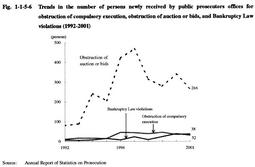| Previous Next Index Image Index Year Selection | |
|
|
3 Other economic offenses Fig. 1-1-5-6 shows the trends in the number of persons newly received by public prosecutors offices over the last decade for obstruction of compulsory execution, obstruction of auction or bids, and Bankruptcy Law violations.
Table 1-1-5-7 shows the trends in the number of persons prosecuted/not prosecuted by public prosecutors offices for obstruction of compulsory execution, obstruction of auction or bids, and Bankruptcy Law violations over the last 5 years. In 2001, of those prosecuted, formal trials were requested for all suspects of the obstruction of compulsory execution. As for the obstruction of auction or bids, formal trials were requested for 85 suspects and summary orders were requested for 34 suspects, and for Bankruptcy law violations, formal trials were requested for all suspects. These offenses usually occur over the collection of bad debts. In particular, collection of bad debts owned by failing financial institutions has become one of the biggest problems in the Japanese economy. Under the Law Concerning Emergency Measures for the Revitalization of the Financial System (Law No. 132 of 1998), the Resolution and Collection Corporation (hereinafter referred to as the "RCC")collects and resolves bad debts purchased from financial institutions, regardless of whether they are already failing or not. In order to rigorously pursue criminal responsibility for offenses related to collection of bad debts owned by failing financial institutions, directors of the RCC, etc. should take necessary actions for charging of such offenses under the Law. In FY 2001, the RCC, etc. brought charges in a total of 32 cases (75 persons), of which 25 (49 persons) were cases involving borrowers and 7 (26 persons) were cases involving loan providers. Among the cases involving borrowers, 8 cases (15 persons charged) were for the obstruction of compulsory execution, 5 cases (11 persons charged) for the obstruction of auction by deception, 1 case (2 persons charged) for making a false entry in an officially authenticated instrument etc., 7 cases (11 persons charged) for fraud, and 4 cases (10 persons charged) for other offenses. Among the cases involving loan providers, 5 cases (18 persons charged) were for breach of trust or aggravated breach of trust and 2 cases (8 persons charged) for other offenses (Source: Deposit Insurance Corporation). Fig. 1-1-5-6 Trends in the number of persons newly received by public prosecutors offices for obstruction of compulsory execution, obstruction of auction or bids and Bankruptcy Law violations (1992-2001) Table 1-1-5-7 Numbers of persons prosecuted/not prosecuted for obstruction of compulsory execution, obstruction of auction or bids, and Bankruptcy Law violations (1997-2001) |

